Reports
Health
Wellness
The Insulin signaling protein type 2 gene (INSIG2) is associated with the synthesis of INSIG2 protein which interacts with transcription factors, activating the synthesis of cholesterol and fatty acids. The variants of the INSIG2 gene have been shown to be associated with body fat accumulation. Specific alleles of this gene are known to either increase or decrease INSIG2 protein levels which are associated with subcutaneous fat accumulation upon exercising.
| CHIP Version | INSIG2 SNPs |
| 23andMe (Use your 23andme raw data to know your INSIG2 Variant) | |
| v1 23andme | Present |
| v2 23andme | Present |
| v3 23andme | Present |
| v4 23andme | Present |
| V5 23andme (current chip) | Present |
| AncestryDNA (Use your ancestry DNA raw data to know your INSIG2 Variant) | |
| v1 ancestry DNA | Present |
| V2 ancestry DNA (current chip) | Present |
| Family Tree DNA (Use your FTDNA raw data to know your INSIG2 Variant) | |
| OmniExpress microarray chip | Present |
In the Framingham Heart Study, people with the C variant of the gene were shown to be associated with obesity, measured in terms of BMI. In a recent similar study conducted on a North Indian population, there was a significant association between INSIG2 gene polymorphism and severe obesity. In another study that analyzed the level of subcutaneous fat, women with the C variant of the gene were shown to be associated with higher levels of baseline subcutaneous fat.
Men with the C variant of the gene were associated with higher gain in subcutaneous fat upon resistance training while men with the G variant showed a loss in subcutaneous fat. In another study, men with the G variant of the allele were shown to be associated with Intramuscular (IMAT) volume in the upper arm after 12 weeks of training than for the subcutaneous fat. In a study on obese children who were on a weight loss program, children with the C variant of the gene were found to lose less weight than children with the G variant.
In a study conducted on Japanese women, the C variant of the gene was shown to have a protective effect on the progression of hypercholesterolemia when on a high fat diet. On an initial analysis in another study, women with the C variant of the gene showed a lower prevalence for hypercholesterolemia.
| Genotype | Phenotype | Recommendation |
| CC | [Limitation] More likely to have higher BMI [Limitation] More likely to have higher subcutaneous fat upon resistance training [Advantage] Less likely to have hypercholesterolemia (Women) | Likely increase in subcutaneous fat upon strength training Including fitness programs, other than strength training might be more beneficial Additional effort may be required to lose weight when compared to people with the G variant |
| CG | Moderate BMI and subcutaneous fat accumulation upon exercising | Likely increase in subcutaneous fat upon strength training Including fitness programs, other than strength training might be more beneficial Additional effort may be required to lose weight when compared to people with the G variant |
| GG | [Advantage] More likely to have lower BMI [Advantage] More likely to have lower subcutaneous fat upon exercising [Limitation] More Likely to have hypercholesterolemia(women) | Likely lower subcutaneous fat upon exercising Strength training has not been shown to be associated with increase in subcutaneous fat upon exercising. There is an increase in Intramuscular volume on training, which may benefit bodybuilders |
“Nutrigenetics, fitness genetics, health genetics are all nascent but rapidly growing areas within human genetics. The information provided herein is based on preliminary scientific studies and it is to be read and understood in that context.”
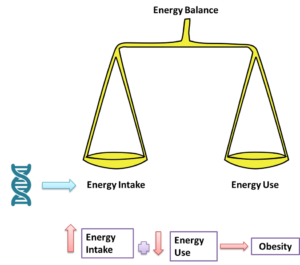
A healthy weight is maintained during a state of energy balance- when the energy intake of an individual matches the energy expenditure. Weight can accrue over a long period of time if the intake is higher than expenditure. Besides intake and expenditure, other factors such as age, basal metabolism, hormonal imbalance, and genetics also influence weight gain or weight loss.
Many humans have inherited genetic adaptations, which evolved to mitigate the ancestral exposure to cycles of feast and famine. Hence, the human body is very good at storing excess energy as fat and reluctant to lose valuable stores (fat) of energy. This is the basis of the ‘thrifty gene’ hypothesis, which explains why people easily put on weight on an excess calorie diet and find it very hard to lose it.
The heritability associated with energy intake among children is found to be between 47-69%. Twin studies showed that there was a genetic influence on the type of food consumed, along with satiety and food cue response.
There are many genes that have been shown to be associated with obesity and energy intake. Of particular significance is the FTO gene. Studies have shown that certain variants of this gene were associated with increased energy intake and increased hunger. Individuals with the abnormal FTO gene weigh at least 3kgs more than individuals who have the normal copy of the gene.
Individuals with an abnormal copy of the FTO gene eat more frequently, with a tendency to prefer calorie-dense foods and larger portions of food. People with the highest risk variant should exert portion control and eat a lot of food rich in fiber which would help quell the hunger. They should also consider frequent snacking in small quantities of low calorie, high protein, and high fiber foods to counteract the perpetual hunger they may be experiencing to maintain a stable glycemic index and stable levels of hunger and satiety hormones.
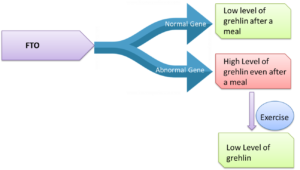
A hormone that plays a key role in satiety is ghrelin. Ghrelin is responsible for ‘hunger pangs’ as it signals the brain to eat. After a meal, the level of ghrelin is lowered and levels of another hormone, Leptin, are elevated resulting in a feeling of fullness. In an individual with the high risk variant of the FTO gene, the level of ghrelin remains high even after a meal, re
sulting in over eating. In such individuals, exercise has been shown to restore the level of ghrelin to normal levels.
Individuals with the abnormal FTO gene should be encouraged to follow a regular exercise pattern which will aid in lowering ghrelin levels and provide better satiety response.
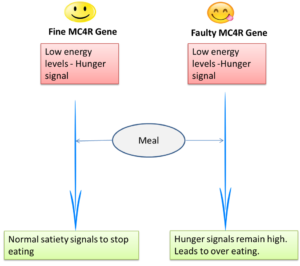
Another important gene that affects meal size and meal choice but not meal frequency is MC4R. When the energy levels drop in our body, the hunger center sends signals that inhibit MC4R and there is an increase in appetite. When the stomach is full after eating, satiety signals are sent by the satiety center that stimulates the MC4R to send signals to stop eating.
Overeating that is induced by distress, emotional eating, leads to binge eating which is highly prevalent in adults who are binge eaters or obese. Binge eating disorder is due to hypersensitivity to reward which results in overeating. The tendency to overeat or binge eat can be determined relatively strongly by analyzing the dopamine D2 receptor gene.
Dopamine is a neurotransmitter and its secretion is increased during emotional upheavals. From an evolutionary aspect, this hormone is released in response to some adverse condition, to prepare the body for a flight or fight response. Under normal circumstances, when dopamine binds to the DRD2 receptor, it should lower feelings of hunger and increase satiety. However, mutations in the DRD2 gene lead to a lower amount of DRD2 in the brain, which could lead to binge eating or overeating.
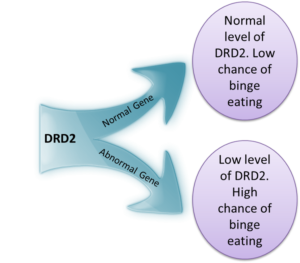
Individuals who carry the abnormal gene should consciously avoid overeating when feeling distressed or should store healthy snacks to eat at times of distress. Another study showed that deficits in the dopamine D2 receptor led mice to be inactive, which in turn lead to weight gain. Therefore, people with an abnormal gene should consciously stay active.
Regulating energy intake can moderate susceptibility to weight gain and obesity and is essential for people with a higher propensity to gain weight. Interventions that promote self-regulation of energy intake have the potential to control weight gain and also encourage healthy dietary habits. When designing intervention strategies, it is important to understand the genetic aspects involved as nearly 30% of obese individuals underreport their energy intake. The most effective way to fight obesity is through calorie restriction or lowering energy intake. People who carry abnormal genes for energy intake should follow mindful eating to ensure a balance in energy homeostasis.
Individuals who carry the abnormal gene should consciously avoid overeating when feeling distressed or should store healthy snacks to eat at times of distress. Another study showed that deficits in the dopamine D2 receptor led mice to be inactive, which in turn lead to weight gain. Therefore, people with an abnormal gene should consciously stay active.
Regulating energy intake can moderate susceptibility to weight gain and obesity and is essential for people with a higher propensity to gain weight. Interventions that promote self-regulation of energy intake have the potential to control weight gain and also encourage healthy dietary habits. When designing intervention strategies, it is important to understand the genetic aspects involved as nearly 30% of obese individuals underreport their energy intake. The most effective way to fight obesity is through calorie restriction or lowering energy intake. People who carry abnormal genes for energy intake should follow mindful eating to ensure a balance in energy homeostasis.
Find out which variations of these genes you carry and more at www.xcode.life
Nutrigenetics, fitness genetics, health genetics are all nascent but rapidly growing areas within human genetics. The information provided herein is to be read and understood in that context.
[hr height="30" style="default" line="default" themecolor="1"]
Stroke, a medical condition is characterized by rapid loss of brain function due to a disturbance in the blood supply to the brain. Stroke is sometimes called a “brain attack.” If blood flow is stopped for longer than a few seconds, the brain cannot get the required oxygen and nutrients through blood and eventually brain cells can die, causing permanent damage.
Sometimes referred to as cerebrovascular accident (CVA), stroke cause rapid loss of brain function due to a disturbance in the blood supply to the brain. This can be due to ischemia (lack of blood flow) caused by blockage (thrombosis, arterial embolism), or a hemorrhage (internal bleeding or loss of blood that occurs from the vascular system into a body cavity). As a result, the affected area of the brain cannot function, which might result in an inability to move one or more limbs on one side of the body, inability to understand or formulate speech, or an inability to see one side of the visual field. A stroke is a medical emergency and if untreated, it can cause permanent neurological damage and death.
[hr height="30" style="default" line="default" themecolor="1"]
[hr height="30" style="default" line="default" themecolor="1"]
Genes that have a vital role in regulating the blood & oxygen supply to the brain through formation & disruption of an atherosclerotic plaque are analyzed for variations which when present, imply that a person has increased risk for stroke.
Our unique genetic profile can make some of us more suitable for endurance activities, others for more intense sprinting activities or power training.
Genes involved in ‘endurance type of activities’ minimize muscle fatigue during prolonged period of mild to moderate intensity exercises, while genes involved in ‘sprinting’ relate to power, rapid bursts of energy, and optimum energy utilisation for activities of shorter duration. Depending upon the expression of Endurance/ Sprinting genes a person is categorized as adaptive for either of these.
There are two different types of muscle fibres which are important for these activities, each type being regulated by specific genes. Type I or slow twitch muscle fibres are mainly responsible for improving endurance. In contrast, Type II or fast twitch muscle fibres allow us to perform rapid, high intensity exercises.
It is a proven fact that regular exercise assures health benefits and improves your fitness level. It is noteworthy that genes determine your adaptability for the type, intensity and duration of activity (endurance/sprinting) based on your capacity for aerobic metabolism, extent of muscle fatigue and the time required for its recovery and slow/fast twitch muscle contraction. Therefore, based on specific variations within these genes in a person’s DNA, the type of exercise (endurance/sprinting) suitable for that person can be determined.
Upload your DNA raw data to Xcode Life. The Gene Fitness Report analyses endurance, weight loss or weight gain with exercise, and more than 15+ such traits.
SNP or Single Nucleotide Polymorphism can simply be termed as copying error made by cells during the process of making new cells wherein a ‘wrong’ nucleotide is present in the DNA sequence in the place of a ‘correct’ nucleotide. For e.g., let’s assume that the normal sequence of a particular section of DNA in humans is AATGCT. A SNP is when the sequence becomes AATGCA, where the last letter (nucleotide) instead of ‘T’ is replaced with ‘A’. These copying errors are like typographical errors which lead to variations in the DNA. These typos in DNA might affect protein function and structure, when present within genes that form these proteins. These variations in the DNA are the root cause for majority of health conditions, differences in response to drugs or diseases etc.
SNPs can be associated with lifestyle related conditions like diabetes, obesity and stroke. These SNPs also contribute to difference in food metabolism e.g. lactose intolerance.
With over 30 million people diagnosed to be diabetic, India is well on its way to becoming the diabetes capital of the world!
Diabetes mellitus is a metabolic disorder that occurs when the body cannot regulate the production or usage of insulin. Insulin is a hormone that converts sugar, starches, and other food into energy. This energy is either used immediately or stored as fat or glycogen. In a diabetic, the body does not produce enough insulin to move the sugar into cells, and the sugar gets accumulated in the blood.
Type 2 diabetes occurs later in life and hence is referred to as adult-onset diabetes. In type 2 diabetes, the muscle and fat cells in the body become resistant to insulin which causes the pancreas to make more insulin. As long as the pancreas continues to produce insulin to overcome this resistance, blood glucose levels remain normal. However, after several years the resistance of the cells continues to increase and the pancreas begins to produce lesser insulin. This result in hyperglycemia (abnormally high levels of sugar in the blood) and the symptoms of type 2 diabetes start manifesting. Type 2 diabetes is most often seen in obese or overweight people and the elderly.
Type 2 diabetes is asymptomatic in the majority of the cases over a long period of time. If symptoms do occur, they include fatigue, increased hunger (polyphagia), frequent urination (polyuria) and increased thirst (polydipsia), blurred vision, erectile dysfunction, and poor wound healing.
Genes have a role in glucose metabolism, and genetic variations within these genes affect their function, thereby increasing the risk for type 2 diabetes.
Coronary heart disease (CHD) is a heart condition which usually results from plaque build-up inside the coronary arteries, which carry oxygen rich blood to the heart. A plaque formation, which is the deposition of cholesterol, narrows these blood vessels and reduces supply of oxygen and blood to the heart. CHD symptoms include shortness of breath and chest pain (angina), while heart attack is its serious manifestation.
Genes have a vital biological role in heart function, blood vessel health (endothelial function), cholesterol & triglyceride metabolism, inflammatory signaling and blood coagulation. There are certain variations in these genes, which have found to be associated with a high risk for Coronary Heart Disease.
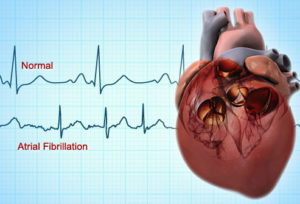
Atrial fibrillation (AF) is the most common type of arrhythmia. An arrhythmia is an abnormality in the heart beat or heart rhythm. During arrhythmia, the heart beat can be either too fast or too slow, or there can be an irregularity in heart rhythm. AF occurs if rapid, disorganized electrical signals cause the heart’s two upper chambers (atria) to fibrillate (contract very fast and irregularly).
Although ,atrial fibrillation itself usually isn’t life-threatening, it is a serious medical condition that sometimes requires emergency treatment as it can lead to other serious complications. Atrial fibrillation may lead to blood clot formation in the heart that may circulate to other organs and lead to blockage of blood flow.
Variations in important genes which have a role in the generation of electrical impulses in the heart muscle, affect the expression of these genes thereby increasing the risk for a disturbance in the contraction of atria leading to their dilation and fibrillation i.e., conferring a genetic predisposition towards AF.
[hr height="30" style="default" line="default" themecolor="1"]
Satiety can be defined as the ‘feeling of fullness’ after eating a meal. For example, have you ever wondered how you fill up with a bowl of oat meal but even three doughnuts leave you feeling hungry? The reason is the comparative satiety levels from the consumption of these foods.
Let us consider in more detail what happens during a meal. At the beginning, eating is rapid, with few pauses between bites. As the meal progresses, eating slows, there are more pauses between bites, and other behaviours such as fidgeting, grooming, or resting increase. A state of satiety is reached when the meal ends. This state is usually associated with a pleasant sensation of fullness or satisfaction. However, unpleasant sensations of nausea and bloating can be associated with satiety following excessive food intake. Of interest is that even when eating has stopped altogether, the introduction of a new food can restart eating.
Genes are involved in the regulation of metabolic rate and energy expenditure which in turn influences body fat accumulation. Some individuals carrying a variation in this gene tend to have “Difficulty in Feeling Full” and are likely to overeat, and overeating in the long run in turn can increase the likelihood for health conditions like obesity.
A genetic test to identify this mutation in an individual followed by appropriate dietary recommendations to overcome this difficulty in feeling full (if mutation is present) will help an individual attain optimal satiety levels.
[hr height="30" style="default" line="default" themecolor="1"]
There is no dearth of recommendations and advice for the healthiest diet in today’s health conscious world.Since our genes respond to the food we eat,biologists at the Norwegian University of Science and Technology (NTNU) have strived to find answers to certain questions at the molecular levels.
Do the food we eat contribute to healthy cellular processes? Are we getting the benefit of what we eat?
Their recent genetic research actually speaks for what the ‘gene’ might consider a healthy food preference, limiting the risks of lifestyle related diseases. The ideal diet must consist of: one-third protein, one- third fat, one- third carbohydrates.
[hr height="30" style="default" line="default" themecolor="1"]
Gene expression refers to the process where information from a gene’s DNA sequence is translated into a substance, like a protein, that is used in a cell’s structure or function. A diet with 65% carbohydrates, causes a number of classes of genes to work overtime. This affects not only the genes that cause inflammation in the body, but also genes associated with development of cardiovascular disease, some cancers, dementia, type 2 diabetes and all major lifestyle-related diseases. A common dietary advice to keep genes healthy and prevent chronic diseases is one that reduces inflammatory reactions in the body and also minimizes the body’s need to secrete insulin.
Dr. Berit Johansen, a professor of biology at NTNU, says “In choosing what we eat, we choose whether we will provide our genes the weapons that cause disease”.
Be it the ‘youth gene’ or the genes that are linked to cardiovascular diseases, a new balanced diet sheet needs to be drawn keeping in mind that every meal has the right amount of fat, protein and good carbohydrates..
[hr height="30" style="default" line="default" themecolor="1"]
Eating disorders can be caused by a mix of sociological, psychological and genetic factors. According to Johansen, “the ability to resist or otherwise, it seems, maybe built into your DNA.” Some noteworthy findings are:
On a positive note, research proves that volunteers showed positive changes within 6 days of diet- change. So remember it’s never too late to alter your food preference in spite of the genetic inclinations.
